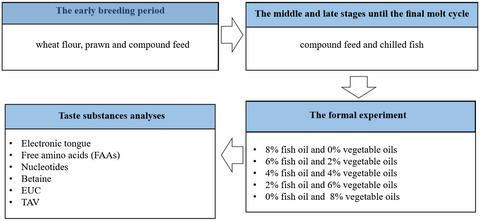当前位置:
X-MOL 学术
›
J. Food Biochem.
›
论文详情
Our official English website, www.x-mol.net, welcomes your feedback! (Note: you will need to create a separate account there.)
Effects of fish oil replacement by blending vegetable oils in fattening diets on nonvolatile taste substances of swimming crab (Portunus trituberculatus).
Journal of Food Biochemistry ( IF 4 ) Pub Date : 2020-07-06 , DOI: 10.1111/jfbc.13345 Ludan Tu 1 , Xugan Wu 2 , Xichang Wang 1 , Wenzheng Shi 1
Journal of Food Biochemistry ( IF 4 ) Pub Date : 2020-07-06 , DOI: 10.1111/jfbc.13345 Ludan Tu 1 , Xugan Wu 2 , Xichang Wang 1 , Wenzheng Shi 1
Affiliation

|
A 45‐day fattening trial was conducted using iso‐nitrogenous and iso‐fatty fattening diets, among which 0%, 25%, 50%, 75%, and 100% of fish oil were, respectively, replaced by blending vegetable oils (canola oil: soybean oil = 1:1), recorded as Diet 1 ~ Diet 5, respectively. The results showed that the meat of crabs (150 ± 25 g) cultured by five fattening feed were distinguished effectively with the electronic tongue. The total free amino acids and taste nucleotides in the meat of crab cultured by Diet 1 were higher than others. The contents of betaine (taste activity value <1) and umami amino acids in the meat of Diet 3 were highest. The contents of sweet amino acids in the meat of crab cultured by Diet 5 was the highest among the different diet. The equivalent umami concentration of Diet 1 was the highest, suggesting that the umami taste is better. In conclusion, 50% of fish oil could be replaced by vegetable oil in fattening feeds.
中文翻译:

在育肥日粮中混合植物油替代鱼油对梭子蟹(Portunus trituberculatus)非挥发性味觉物质的影响。
使用等氮和等脂肪的育肥日粮进行了为期 45 天的育肥试验,其中 0%、25%、50%、75% 和 100% 的鱼油分别被混合植物油(菜籽油油:豆油=1:1),分别记为饮食1~饮食5。结果表明,5种育肥饲料养殖的蟹肉(150±25g)用电子舌能有效区分。饮食1培养的蟹肉中总游离氨基酸和味觉核苷酸均高于其他方法。饮食3肉中甜菜碱(味觉活性值<1)和鲜味氨基酸含量最高。饮食5培养的蟹肉中甜氨基酸含量在不同饮食中最高。饮食1的当量鲜味浓度最高,暗示鲜味更好。总之,育肥饲料中 50% 的鱼油可以被植物油替代。
更新日期:2020-09-14
中文翻译:

在育肥日粮中混合植物油替代鱼油对梭子蟹(Portunus trituberculatus)非挥发性味觉物质的影响。
使用等氮和等脂肪的育肥日粮进行了为期 45 天的育肥试验,其中 0%、25%、50%、75% 和 100% 的鱼油分别被混合植物油(菜籽油油:豆油=1:1),分别记为饮食1~饮食5。结果表明,5种育肥饲料养殖的蟹肉(150±25g)用电子舌能有效区分。饮食1培养的蟹肉中总游离氨基酸和味觉核苷酸均高于其他方法。饮食3肉中甜菜碱(味觉活性值<1)和鲜味氨基酸含量最高。饮食5培养的蟹肉中甜氨基酸含量在不同饮食中最高。饮食1的当量鲜味浓度最高,暗示鲜味更好。总之,育肥饲料中 50% 的鱼油可以被植物油替代。

























 京公网安备 11010802027423号
京公网安备 11010802027423号